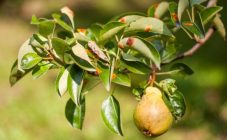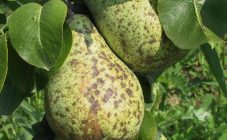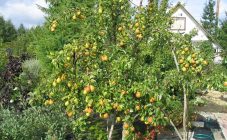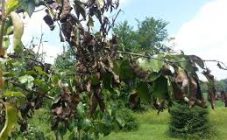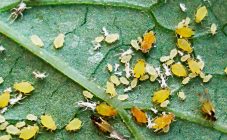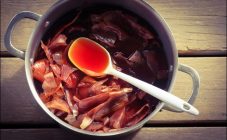Aphids are small insects, only a few millimeters in size. A proboscis is located on the head, with which aphids pierce the surface of plants. These insects are carriers of viral plant diseases and can form pathological growths - galls on various parts of plants.
Aphids are a dangerous pest of garden plants, parasitizes on leaves, buds, shoots, feeds exclusively on plant sap. This attack did not bypass the side and pear. If the leaves of pears changed shape, began to curl, dry out, the shoots changed color, most likely, aphids parasitize on the fruit tree, which leads to a decrease in yield, sometimes even to the drying of the plant.
How to deal with aphids on a pear
If you use an integrated approach, the fight against aphids on a pear is not difficult. There are the following methods of struggle.
- Quarantine - inspection of imported plants for the presence of harmful insects. If found, import is prohibited.
- Agrotechnical - loosening, covering the soil with mulch, destroying root growth, since larvae and aphid eggs can be found in the soil, grass under trees.
- Chemical - the use of chemicals: pyrethroids, neonicotinoids, organophosphorus compounds. Spraying with chemicals can only be done before fruit formation or after harvest. During the fruiting period, the use of chemicals is strictly prohibited. The most effective way is to spray with Kinmix until the buds swell, before flowering with Agravertin, after the fruit set with Iskra.
- Biological - the use of drugs of biological origin, the treatment of trees and the soil under them, which will help save the harvest. Some insects feed on aphids: lacewings, ladybugs, wasps. You can plant them on leaves, tree branches. It is also advisable to grow mint, dill, yarrow next to pear trees, they attract insects that feed on aphids. It is necessary to destroy ants, since aphids live with them in symbiosis. The ant, especially the black one, leads to a greater dispersal of aphids.
- Mechanical - if a small number of harmful insects are found, they can be knocked down with a strong pressure of water from a hose. However, after that you need to remove the aphid from under the tree, bury it with deep loosening.
- in spring - immediately after the snow melts, nitrogen fertilizers are applied, after flowering - organic;
- in summer - June is favorable for the application of fertilizers that increase the resistance to diseases and pests (salts with nitrogen, trace elements);
- in the fall - organic, phosphorus-potassium fertilizers, ash.
Aphids settle on plants weakened from both lack and excess of fertilizers. Therefore, overfeeding and underfeeding of trees are equally dangerous.
Drugs
If, nevertheless, aphids appeared on the leaves of a pear, how to fight? Below are the main drugs.
FUFAFON (CARBOFOS)
Method of application: 70 g of the drug per bucket of water. One tree needs from 2 to 5 liters of the prepared solution.
Pros: Fufafon acts directly on aphids, without having a negative effect on trees, is not absorbed into the fruit. It also destroys the moth, sawfly, and weevil.
Cons: not strong enough.Sometimes it is necessary to re-treat the plant to achieve the desired effect.
AKTELIK
Method of application: Add 2 milliliters of Aktelika to 2 liters of water. For one tree from 2 to 5 liters of solution, depending on the size of the plant.
Pros: Protects against most pests. The duration of the drug is up to three weeks.
Cons: highly hazardous substances. Absorbed into the plant. Cannot be used when blooming.
BANKOL
Method of application: Add 5 g of the preparation to a bucket of water. Sprayed at the rate of 10 liters of solution per 100 square meters of area.
Pros: protection against the main pests of fruit trees. The maximum effect is achieved on day 3. The duration of the protective action is up to three weeks.
Cons: highly hazardous substances. They are removed from the plant for a long time. During flowering, the drug is not used.
AKTARA
Method of application: 10 g of the drug per 10 liters of water. For spraying from 2 to 5 liters of water, depending on the size of the pear tree.
Pros: The drug is not removed by rain, running water. The protective effect lasts for about a month. It also destroys other pests of the orchard.
BIOTLIN
Method of application: 2-4 milliliters of Biotlin per 10 liters of water. One tree should be treated with 2-5 liters of water.
Pros: destroys most pear tree pests. The protective effect lasts 4 weeks. The drug is stable, cannot be removed by rain or running water.
Cons: toxic to the human body. It is absorbed into the plant, into the fruit.
Folk ways to combat aphids
If aphids appear on a pear, how can it be safely treated? Folk recipes have many advantages:
- have less toxicity;
- ease of use;
- economically more profitable.
Dandelion or chamomile decoction. Pour 0.5 kilograms of shoots with 1 liter of water. Put in a dark place for a day. Then put on fire, boil for 15 minutes. Grate 3 heads of garlic, add to the broth, cook for 4-7 minutes. Strain, add a bucket of warm water and 30 g of green soap. Spray the garden once every 7 days after the heat has subsided.
Infusion from the tops of the Solanaceae family (potatoes, tomato). Pour 1 kilogram of tops with 10 liters of water. Leave on for 24 hours. Before spraying the plants, add a piece of laundry soap to the infusion. Treat once every 7 days after the heat has dropped.
Soap solution. Trim a couple of bars of laundry soap, completely dissolve the soap in a bucket of warm water. For best results, you can add tobacco infusion.
Ammonia. Dilute 50 ml of alcohol with a bucket of water. Spray the trees with the solution. You can add soapy water.
Vinegar. Add 2 tablespoons of vinegar to 10 liters of water. The resulting solution is weak to damage the plant. But the persistent smell of vinegar will drive the aphids from the leaves. If the pear is young, then its leaves can be processed with a spray bottle.
Prevention
It is easier to prevent the appearance of aphids than to get rid of them later. Therefore, preventive measures are essential.
- Pear trees should be planted in a bright place, the area should be open, with few trees, so that the garden is better ventilated.
- In late autumn, cracks in the bark are treated with an antiseptic, the damage is covered with pitch. The trees are whitewashed with lime. The near-trunk circle is dug up, it is advisable to mulch the soil under the plant.
- In the fall, hot water is poured over the tree trunk to destroy the aphid eggs.
- In the spring, a trapping belt with an adhesive strip is applied to the tree to prevent pests from crawling onto the tree from the soil.
- In early spring, trees are treated with insecticides.
- Plants with a sharp aroma (garlic, dill, lavender, mint) are planted next to the pear. They will scare away aphids.
In order for the pear garden to be healthy and bring a good harvest, it is necessary to carry out year-round prevention. When harmful insects appear, they need to be dealt with by any available means.





